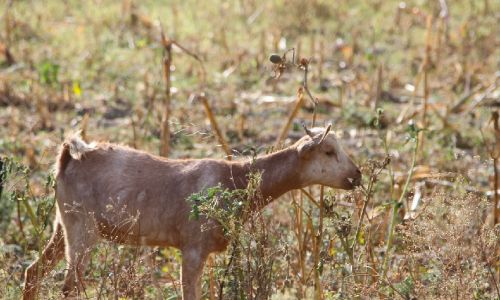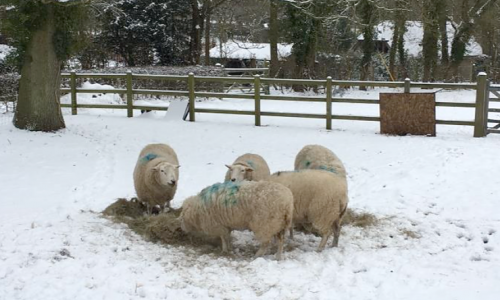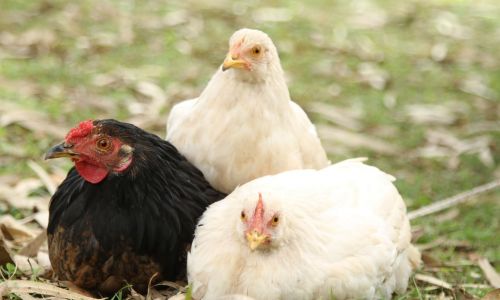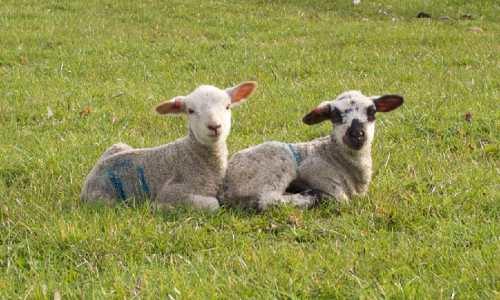Working and eating towards a sustainable future: Part One
Part One
Kate Blaszak, World Animal Protection
In these challenging times, vets can be consumers, advisers, leaders and advocates of a humane and sustainable future - or embedded in a very unsustainable present. What on earth do I mean and what legacy do we want to leave individually or as a profession? This is the first of a two-part series looking at the role of vets and challenges associated with conventional farming. The second part will focus on some sustainable solutions and opportunities for vets.
Vets are involved in almost every sector and stage of farming systems across the globe. I’m a vet with a global technical remit for farm animal welfare and farming systems, and a background in epidemiology and international animal health. I’m based in Asia, which currently produces 87% of the world’s aquaculture, 90% Crustacea, 58% of the pigs, 35% chicken and 65% of the eggs [1]. While farm animals and vets have played a key role in livelihoods, food security and wider community benefits, smallholders are fast being replaced with large, consolidated and intensive farming systems in this region, following others. Vets are increasingly part of such systems in most countries.
We face several major challenges globally in relation to the current food, specifically animal protein system. While a billion people are starving or undernourished, over 2 billion are overweight or obese, often concurrently suffering from cardiovascular, liver disease or diabetes. Globally, food security and food justice is actually now - and up to 2050 - within our reach without further destroying the planet, if we collectively transform [2][3]. Yet, Rabobank, one of the largest private investors of agriculture globally, projects at least 25% more demand in animal protein in next 20 years (2017-2037) and that 90% of global growth will be in emerging markets, 60% of that in Asia. Aquaculture is the fastest growing industry and two thirds of growth will also be in Asia [4]. The latter projections essentially assume business as usual and expansion of industrial animal farming.
Industrial farming (and by that, I mean, in its simplest terms, intensively raised, grain fed production) accounts for at least 50 billion of over 70 billion farm animals consumed annually [5]. This involves animals in a permanent, barren state of ‘lockdown’ – layer hens in cages predisposed to osteoporosis and fractures [6], sows in crates unable able to turn around, suffering stereotypies, depression and various infections [7], broilers suffering up to 25% lameness [8] and a range of other skeletal, cardiovascular and skin problems due to a 300% increase in growth rate [9][10], and metabolic exhaustion, lameness, tethering or grazing deprivation of many dairy animals [11]. Also, fundamental to enabling highly stressed animals to produce for maximum efficiency and profit, is routine use of painful procedures, antibiotics and highly concentrated feeding systems, which leave breeding animals chronically hungry. In addition, around 2 billion animals are live-exported annually [12] worth > USD18 billion [13]. This trade is also a significant source of disease spread and lax welfare standards, yet is increasing globally [14].
Irrespective of your animal welfare interest, one can’t deny the figures of inefficiency in the conversion of edible feed to animal protein. More than a third of the world’s cereals and most of the soya is fed to livestock. This wastes more than two thirds of the calories and protein in conversion to meat, milk and eggs and contributes to food insecurity where land is used to feed livestock instead of feeding people directly [15]. For every 100 grams of protein in human-edible cereals fed to animals, just 43 grams of protein enter the human food chain as meat or milk [16]. Studies indicate that livestock only enhance food security when they convert materials that we cannot consume – into food we can eat [17][18]. Additionally, 25% of food calories are discarded and wasted post-harvest [19] or around a 1/3 in total [20].
Despite only contributing 18% calories and 37% protein (including farmed fish), industrial farming has an enormous planetary footprint. Livestock production produces around 60% of agricultural greenhouse gases and 56% air pollution, and consumes 57% of water and 83% of farm land use globally. Livestock production withdraws around one third of agriculture’s freshwater [21] (or 16% of total global use) and uses a third of the planet’s ice free land [22]. It has caused major soil degradation and 50% of terrestrial erosion, with scientists predicting only 60 years of farming remain [23]. Industrial farming has led to 60% of nitrogen and 70% phosphorus pollution [24] causing major water (including groundwater) contamination and over 400 riverine and marine dead zones via eutrophication [25].
Livestock production is also the single most powerful driver of habitat and biodiversity loss on Earth [26]. Much of the deforestation occurs in tropical regions, which have very high biodiversity and carbon sequestration. In Amazonia, at least 80% of all deforested land has been converted to pasture for grazing cattle, with much of the remaining 20% used to grow animal feed [27]. The proportions may further shift as in many locations, clearing initially for smallholder farms is subsumed by intensive ranching and monocultures. Much of the feed (especially soya) is destined for Asia’s industrial farming; China imports around 60% of all Brazilian soya [28]. Along with deforestation is use of fire, which further compounds the release of carbon [29]. Cumulatively, all these activities plus animal emissions themselves deliver a massive carbon emissions tally, which is between 14.5-20% of all GHGs produced globally.
Overgrazing, competition, hybridisation and persecution of top predators also directly leads to changes in ecosystems, compounding any deforestation, habitat and biodiversity loss [30]. Resultant interactions or wildlife-livestock conflict can result in emerging and novel infectious diseases, as vets would be acutely aware. A meta-analysis from 100 years of relevant publications found increasing disease emergence from increasing wildlife – livestock interfaces [31]. Additionally, large reservoir populations of genetically uniform animals, exemplified in industrial farms, enables amplification, conversion and mutation of viruses as seen in swine and bird flu pandemics [32]. And few would need another reminder of the role that live animal markets and emerging viruses play in the pandemic we find ourselves in.
Meanwhile, the excessive and irresponsible use of antimicrobials props up low welfare farming. Conservatively, antibiotic use for livestock accounts for two thirds of the global use of antibiotics, and 72% of academic studies found evidence of a link between antibiotic consumption in animals and resistance in humans [33]. Most use is for livestock growth promotion and metaphylaxis, often authorised, unregulated or with the general approval or discretion of vets. Up to 90% of antibiotics provided to animals are excreted and enter our environment via effluent, waste water, crop fertiliser and insects, fish, rats and birds. Up to 75% of antibiotics used in aquaculture may be lost to the environment [34].
Historically, many vets have staunchly resisted the call to decouple prescription and sales of veterinary drugs. However, we must review our motivations and responsibilities today, especially in relation to livestock production. Some countries have opted to decouple (e.g. Denmark) while others have dis-incentivised sales, establishing national reduction targets (eg. Netherlands). Sweden has some of the lowest comparative antibiotic use globally and leads the way in higher welfare farming as a key part of the solution. The World Bank has reported on the projected global cost of AMR and a potentially post-antibiotic world, while a recent study has attempted to model the external public health costs of AMR to public health and society [35]. This and many other externalities of the industrial farming model maintain a cycle of hidden costs for cheap and unsustainable animal protein.
Finally, investors have acknowledged farm animal welfare [36] and many other material risks associated with the industrial farming model [37][38], which essentially ignores the climate [39], planetary [40] and food crises [41], plus pandemic and antimicrobial resistance risks which threaten the World’s economy, food security and several UN Sustainable Development Goals [42]. Business as usual in the global livestock industry is simply not sustainable, and perhaps it’s also no longer for vets?
Kate Blaszak
Head of Research and Animal Welfare (Animals in Farming), at World Animal Protection.
References
[1] FAO Food Outlook (May 2019) – biannual report on global food markets: http://www.fao.org/3/ca4526en/ca4526en.pdf
[2] Berners-Lee et al, 2018. Current global food production is sufficient to meet human nutritional needs in 2050 provided there is radical societal adaptation. Elem Sci Anth, 6: 52 https://www.elementascience.org/articles/10.1525/elementa.310/
[3] The future of food and agriculture: Alternative pathways to 2050. FAO 2018_228 pp. http://www.fao.org/publications/fofa/en/
[4] Rabobank Global Animal Protein Market Outlook to 2037 (Nov 2019): Last accessed 30/1/20 https://conferences.au.dk/fileadmin/conferences/2019/bioeconomy/Talks__June_26/Nan-Dirk_Mulder_Foulum_26062016.pdf
[5] Global meat and dairy production. Updated Nov 2019 using FAOstat 2018 figures https://ourworldindata.org/meat-production Last accessed 25/2/20
[6] Farm Animal Welfare Council, 2010. Opinion on osteoporosis and bone fractures in laying hens.
[7] World Animal Protection global pig welfare framework (scientific backing available on request)
[8] Knowles, T et al. 2008 Leg disorders in broiler chickens: prevalence, risk factors and prevention. PLOS ONE https://journals.plos.org/plosone/article?id=10.1371/journal.pone.000154
[9] Dixon, L. 2020. Slow and steady wins the race: the behaviour and welfare of commercial faster growing broiler breeds compared to a slower growing breed. PLOS ONE https://journals.plos.org/plosone/article?id=10.1371/journal.pone.0231006
[10]Eat, sit, suffer, repeat – the life of a typical meat chicken. 2020 https://www.rspca.org.uk/webContent/staticImages/BroilerCampaign/EatSitSufferRepeat.pdf
[11] von Keyserlingk and Weary. 2017. A 100-Year Review: Animal welfare in the Journal of Dairy Science—The first 100 years. J. Dairy Sci. 100:10432–10444 https://www.journalofdairyscience.org/article/S0022-0302(17)31029-9/fulltext
[12] Live export: animals at risk in giant global industry. The Guardian (2020). Last accessed 21/1/20 https://www.theguardian.com/environment/2020/jan/23/how-the-middle-easts-water-shortage-drives-demand-for-live-animal-imports
[13] The Global live export trade worth over USD 18Billion (2017) last accessed 28/1/20 https://www.maritime-executive.com/article/live-export-global-trade-worth-18-billion
[14] Animals Farmed investigates the huge global trade in live animals (2020): https://www.theguardian.com/environment/2020/jan/20/animals-farmed-investigates-the-huge-global-trade-in-live-animals
[15] CIWF Strategic Plan 2018-2022 last accessed 27/1/20
[16] Berners-Lee et al, 2018. Current global food production is sufficient to meet human nutritional needs in 2050 provided there is radical societal adaptation. Elem Sci Anth, 6: 52 https://www.elementascience.org/articles/10.1525/elementa.310/
[17] : Schader C et al. 2015 Impacts of feeding less food-competing feedstuffs to livestock on global food system sustainability. J. R. Soc. Interface 12: 20150891. http://dx.doi.org/10.1098/rsif.2015.0891
[18] Bajželj et al, 2014, Importance of food-demand management for climate mitigation. Nature Climate Change, Vol 4, October 2014
[19] CIWF Strategic Plan 2018-2022 last accessed 27/1/20 https://assets.ciwf.org/media/7432824/ciwf_strategic-plan-revise18-lr2.pd
[20] Climate change and land report UN IPCC media (2019) https://www.ipcc.ch/2019/08/08/land-is-a-critical-resource_srccl/
[21] Damian Carrington, "Avoiding meat and dairy is ‘single biggest way’ to reduce your impact on Earth", The Guardian, 31 May 2018 (page visited on 22 Jan 2020).
[22] Animal Agriculture’s impact on climate change. Climate Nexus https://climatenexus.org/climate-issues/food/animal-agricultures-impact-on-climate-change/
[23] Arsenault, C., Only 60 years of farming left if soil degradation continues. Scientific American. 5th December 2014. https://www.scientificamerican.com/article/only-60-years-of-farming-left-if-soil-degradation-continues/
[24] Animal Agriculture’s impact on climate change. Climate Nexus https://climatenexus.org/climate-issues/food/animal-agricultures-impact-on-climate-change/
[25] Deadzone national geographic resource library. Last accessed 30/1/20 https://www.nationalgeographic.org/encyclopedia/dead-zone/
[26] Machovina, B., Feeley, K. J., & Ripple, W. J. 2015. Biodiversity conservation: The key is reducing meat consumption. Science of the Total Environment, 536: 419–431.
[27] Machovina, B., & Feeley, K. J. 2014. Meat consumption as a key impact on tropical nature: A response to Laurance et al. Trends in Ecology and Evolution, 29: 430–431.
[28] Transparent supply chains for sustainable economies- maps the trade and use of Brazilian soy (2003 - 2017) Last accessed 6/3/20 https://trase.earth/flows?toolLayout=1&mapView=23.08%2C-86.48%2C
[29] Unsustainable cattle ranching. WWF. Last accessed 30/1/20 https://wwf.panda.org/knowledge_hub/where_we_work/amazon/amazon_threats/unsustainable_cattle_ranching/
[30] Less is more. Greenpeace 2018 scientific background report pp. 15,16 https://storage.googleapis.com/planet4-international-stateless/2018/03/6942c0e6-longer-scientific-background.pdf last accessed 29/1/20
[31] Wiethoelter, A. K., Beltrán-Alcrudo, D., Kock, R., & Mor, S. M. 2015. Global trends in infectious diseases at the wildlife–livestock interface. Proceedings of the National Academy of Sciences, 112: 9662–9667.
[32] Dhingra et al, Geographical and Historical Patterns in the Emergences of Novel Highly Pathogenic Avian Influenza (HPAI) H5 and H7 Viruses in Poultry Front. Vet. Sci., 05 June 2018 | https://www.frontiersin.org/articles/10.3389/fvets.2018.00084/full
[33] O’Neill J (2015) Antimicrobials in agriculture and the environment: Reducing unnecessary use and waste.
[34] UN Environment Protection. Frontiers 2017: Emerging Issues of Environmental Concern
[35] Innes et al, 2020 External Societal Costs of Antimicrobial Resistance in Humans Attributable to Antimicrobial Use in Livestock
Annual Review of Public Health 41 https://www.annualreviews.org/doi/abs/10.1146/annurev-publhealth-040218-043954
[36] BBFAW. Farm animal welfare is a key source of business risk and of commercial opportunity for food companies https://bbfaw.com/investors
[37] Factory farming in Asia: Assessing investment risks https://www.fairr.org/article/factory-farming-in-asia-assessing-investment-risks/
[38] FAIRR Climate risk tool, report (summary deck available) https://dev.fairr.org/research/climate-risk/
[39] Climate change and land report UN IPCC media (2019) https://www.ipcc.ch/2019/08/08/land-is-a-critical-resource_srccl/
[40] Campbell, B. M., et al. 2017. Agriculture production as a major driver of the earth system exceeding planetary boundaries. Ecology and Society, 22: 8.
[41] Climate change and land systems. UN IPCC 2019 report: Chapter 5 food security, p12 last accessed 27/1/20 https://www.ipcc.ch/site/assets/uploads/sites/4/2019/11/08_Chapter-5.pd
[42] The Global Risks Report, 2020. World Economic Forum. https://www.weforum.org/reports/the-global-risks-report-2020
Created by a group of farm animal, aquaculture and wildlife population health experts
Our Food and Farming working group is supporting the transition towards regenerative agriculture — the conservation and rehabilitation of food and farming systems.



